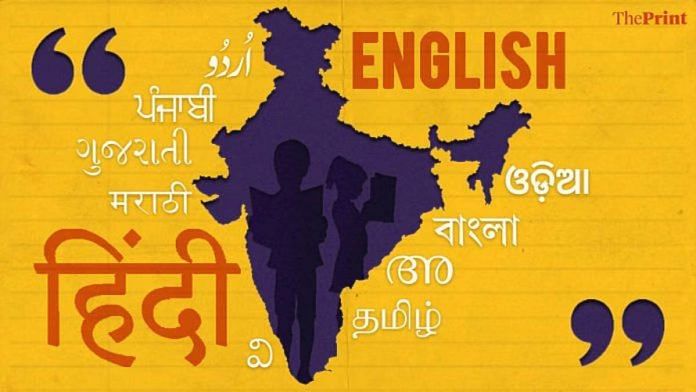Thank you dear subscribers, we are overwhelmed with your response.
Your Turn is a unique section from ThePrint featuring points of view from its subscribers. If you are a subscriber, have a point of view, please send it to us. If not, do subscribe here: https://theprint.in/
India speaks in many tongues—22 official ones, hundreds more unofficially, and thousands of dialects echoing across its cities, villages, mountains, and coasts. This diversity is not just linguistic; it is emotional, cultural, deeply rooted in memory and belonging. But it also makes India’s language politics uniquely complex—and at times, combustible.
Every few years, the question of Hindi resurfaces. Not just in classrooms or on signage, but in Parliament, policy papers, and protests. The latest spark? A recommendation by a parliamentary committee—headed by the Union Home Minister—that Hindi be used more widely in government work and education, including in technical institutions across India.
Predictably, it set off a firestorm, especially in the South and Northeast. The worry: that promotion might slip into imposition. That a unifying language might become a dominating one. That a bridge might feel like a bulldozer.
I write this not as a flag-bearer for any side, but as someone who loves Hindi—not above other languages, but alongside them. This is not about asserting Hindi’s supremacy, but about honestly asking: how can India, in all its noisy, glorious plurality, find linguistic harmony?
This isn’t a new debate. Back in 1949, as the Constitution was being drafted, the national language question nearly tore the Assembly apart. Hindi was championed by many from the Hindi heartland, but Tamil Nadu and other southern states saw it as a cultural imposition. The eventual compromise declared Hindi as the official language of the Union, but retained English as an associate official language—a stopgap that quietly became permanent.
The tension never fully disappeared. From the anti-Hindi agitations in Tamil Nadu in the 60s, to ongoing concerns in the Northeast over linguistic erasure, language has always been a deeply emotional issue in India—because it is tied so intimately to identity.
The recent proposal doesn’t demand that Hindi replace all other languages. However, it does suggest that Hindi be given more space in central government operations and educational institutions—even in non-Hindi-speaking states. That’s enough to trigger unease. It’s a fair concern. There’s a line between encouraging a language and enforcing it. And when that line is blurred, people push back—not just on principle, but from lived experience.
At the same time, there’s an argument to be made for a common thread. Hindi is not a foreign language. It’s spoken by over 40% of Indians. It thrives in Bollywood, in migrant labour markets, on Instagram reels, and railway platforms. It has grown not because of force, but because of function.
Should that organic role be nurtured? Absolutely. But should it come at the cost of Tamil, Bengali, Malayalam, or Khasi? Never.
For many Indians, especially in the South and Northeast, language is more than utility—it’s pride, memory, even resistance. In Tamil Nadu, the anti-Hindi movements weren’t just about vocabulary—they were about identity and autonomy. In Manipur or Nagaland, mother tongues are often the last line of defence against cultural dilution. It feels unjust to ask a Kannadiga or a Manipuri student to learn Hindi compulsorily, when a Hindi speaker is never expected to learn their language in return. If we’re talking about national integration, should it not be mutual?
India’s strength has often come from accommodation, not assimilation. The States Reorganisation Act of 1956, which created states based on linguistic identities, is a quiet success story of Indian federalism. Undermining that spirit could have long-term consequences.
The way forward is a four-prong solution:
- Reimagining the Three-Language Formula: Let students across the country learn a regional language, Hindi (or another Indian language), and English—with flexibility. But also ensure that students in Hindi-speaking states learn a non-Hindi Indian language. It builds empathy and mutual respect.
- Promote, Don’t Mandate: Let Hindi grow where it fits—on OTT platforms, music, optional courses, cultural exchanges. But don’t make it compulsory in institutions or exams where it alienates.
- Celebrate Regional Languages: Let there be translations—not just of Hindi literature into other languages, but vice versa. India’s stories don’t live in one tongue alone.
- Build a Digital Future for All Languages: If Hindi must grow online, so must Bhojpuri, Manipuri, Konkani, Dogri, and others. Languages need not fight for space—they can all belong.
Let’s be clear—Hindi does have a place in India’s story. However, that place must be earned through connection, not command. It must invite, not impose. India doesn’t need one national language to feel like one nation. What it needs is a deeper linguistic humility—an understanding that unity can come not from uniformity, but from mutual recognition.
Let Hindi be a bridge—not a border. Let every Indian language walks alongside it, not behind it.
These pieces are being published as they have been received – they have not been edited/fact-checked by ThePrint.


